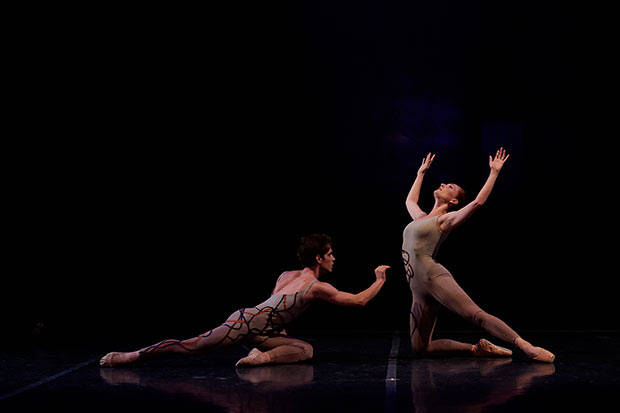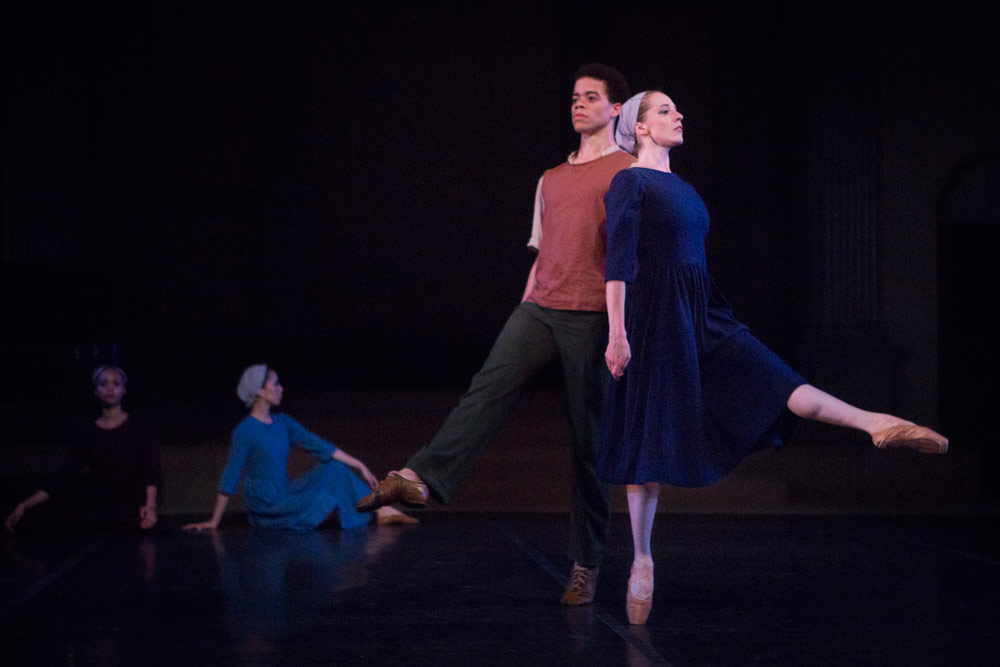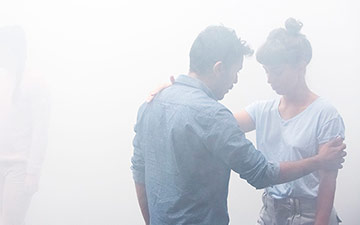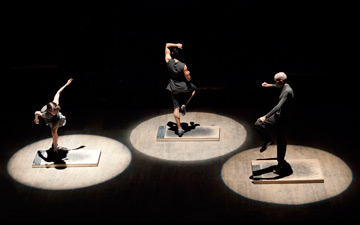
© Rachel Neville. (Click image for larger version)
New York Theatre Ballet
Beethoven/1999, Optimists, Dark Elegies, Double Andante
★★★✰✰
New York, Florence Gould Hall
10 February 2018
nytb.org
www.fiaf.org/rental/florence-gould-hall
Staying Small in the Big City
Quietly, quietly, on the margins of New York’s ballet scene, New York Theatre Ballet has been doing good work for four decades. The operation is small: thirteen dancers, a pianist, a beautiful but cramped studio space in an East Village church, a small school staffed by the company and its director Diana Byer. They tour and perform children’s ballets to stay alive. But they also present evenings of repertory, small chamber-sized works that would otherwise fall through the cracks at the bigger companies, like Frederick Ashton’s La Chatte Metamorphosée en Femme and Jerome Robbins’ Rondo (coming this spring).
Byer is also a promoter of new work, particularly by women. The prominent British modern-dance choreographer Richard Alston fell in love with the company a few years ago and has created or revived several works for them. As has Gemma Bond, a budding choreographer who dances with American Ballet Theatre; Byer has commissioned her several times, and in the process Bond has grown immensely. (This season she is creating a work for Washington Ballet.) For Pam Tanowitz, a more established modern-dance choreographer, working with NYTB was a chance to experiment with ballet technique, particularly the clean, well-placed (unexaggerated) Cecchetti technique that Byer teaches at the school and in company class.

© Yi-Chun Wu. (Click image for larger version)
Works by Bond and Tanowitz were included in this evening’s performance, along with a quartet by the downtown veteran David Gordon and Antony Tudor’s mournful Dark Elegies. All were danced with the quiet focus, lucidity, and unfussy delivery that characterize the company. No attention-grabbing fireworks, and how would that even be possible in the neutral setting of Florence Gould Hall, an business-like space beneath the French Institute Alliance Française in Midtown?
That said, the company is looking particularly good right now. In addition to stylish, witty dancers like Amanda Treiber and Elena Zahlmann, and the stalwart Steven Melendez, there are a few promising additions, two of them from the Gelsey Kirkland Ballet, now on hiatus. Erez Milatin in particular: an Israeli dancer with a juicy plié, a light springy jump, and an ardent demeanor. He and Treiber danced together in Optimists, a pas de deux by Bond from last year, set to the fast movement of Prokofiev’s Eighth Piano Sonata, played by Michael Scales. It’s an odd, hyperactive little duet, performed in Graham-like veined unitards under very dim light. Not sure what to make of it. In contrast, Tanowitz’s Double Andante (from 2015) is a playful deconstruction of the formalities of ballet, set to the Andante from Beethoven’s Sonata in D Major, played twice, at different tempos. The dancers mill about, do their exercises, practice their port de bras, and suddenly break into little tap routines – or fall over. Quirky and smart, if a little slight.

© Robert Altman. (Click image for larger version)
The pièce de resistance was Dark Elegies, a study in mourning based on Mahler’s Kindertotenlieder (here to a recording), which I always find less moving than I should – too earnest, perhaps? But first, a short miniature by David Gordon (Beethoven/1999) for four dancers in street clothes. They walked, held hands, and occasionally looked up, or out at the audience, or at each other, as if about to receive or reveal a secret. Diana Byer appeared during a short pause to read a passage from an essay written by E.B. White in the thirties, about the importance of integrity in politics and a free press. (Sigh.) And that was that.

© Rachel Neville. (Click image for larger version)
A quiet program for a quiet New York evening.

















I think your otherwise well-written review could have done without the “sigh” at the end. Dark Elegies is an obvious masterpiece of a work, and NYTB has the perfect aesthetic and training to perform it! The entire performance — even though Elegies would be the highlight of any program — made me glad to be alive and living in NYC.
I disagree. That sigh expressed volumes without insulting anyone,